Iron Deficiency in Indigenous Pregnant Women: A Public Health Proposal
VerifiedAdded on 2023/03/23
|16
|4098
|32
Report
AI Summary
This report presents a public health proposal addressing iron deficiency in Australia, with a specific focus on Indigenous pregnant women. The report begins by defining the problem, highlighting the prevalence of iron deficiency anemia (IDA) among this target population compared to the general Australian population, and discussing key determinants such as socioeconomic disadvantage, limited access to healthcare, and cultural factors influencing dietary practices. The consequences of IDA, including fatigue, complications during pregnancy, and reduced life expectancy, are also explored. The proposed public health approach centers on the double fortification of salt with iron and iodine. The report justifies this approach by examining the strength of evidence, emphasizing its cost-effectiveness, widespread acceptability, and feasibility. The report includes two pieces of evidence supporting the efficacy of iron fortification, including a meta-analysis of randomized controlled trials. The conclusion reinforces the importance of addressing iron deficiency through salt fortification to improve health outcomes for Indigenous pregnant women and the broader Australian population. The report provides detailed references to support all claims and recommendations.

Table of Contents
Part A...................................................................................................................................2
Public Health Issue: Iron Deficiency...............................................................................2
Prevalence........................................................................................................................2
Determinants....................................................................................................................3
Consequences..................................................................................................................3
Part B...................................................................................................................................4
Description of Approach..................................................................................................4
Strength of Evidence........................................................................................................5
Equity...............................................................................................................................6
Acceptability....................................................................................................................6
Feasibility........................................................................................................................7
Part C...................................................................................................................................7
Evidence 1.......................................................................................................................7
Aims and Relevance....................................................................................................7
Study Design and Methods..........................................................................................8
Results and Discussion................................................................................................8
Strengths and Limitations............................................................................................8
Implications.................................................................................................................8
Conflicts of Interest.....................................................................................................9
Part A...................................................................................................................................2
Public Health Issue: Iron Deficiency...............................................................................2
Prevalence........................................................................................................................2
Determinants....................................................................................................................3
Consequences..................................................................................................................3
Part B...................................................................................................................................4
Description of Approach..................................................................................................4
Strength of Evidence........................................................................................................5
Equity...............................................................................................................................6
Acceptability....................................................................................................................6
Feasibility........................................................................................................................7
Part C...................................................................................................................................7
Evidence 1.......................................................................................................................7
Aims and Relevance....................................................................................................7
Study Design and Methods..........................................................................................8
Results and Discussion................................................................................................8
Strengths and Limitations............................................................................................8
Implications.................................................................................................................8
Conflicts of Interest.....................................................................................................9
Paraphrase This Document
Need a fresh take? Get an instant paraphrase of this document with our AI Paraphraser

Relevant References....................................................................................................9
Evidence 2.......................................................................................................................9
Aims and Relevance....................................................................................................9
Study Design and Methods..........................................................................................9
Results and Discussion..............................................................................................10
Strengths and Limitations..........................................................................................10
Implications...............................................................................................................10
Conflicts of Interest...................................................................................................10
Relevant References..................................................................................................10
Conclusion.........................................................................................................................11
References..........................................................................................................................12
Evidence 2.......................................................................................................................9
Aims and Relevance....................................................................................................9
Study Design and Methods..........................................................................................9
Results and Discussion..............................................................................................10
Strengths and Limitations..........................................................................................10
Implications...............................................................................................................10
Conflicts of Interest...................................................................................................10
Relevant References..................................................................................................10
Conclusion.........................................................................................................................11
References..........................................................................................................................12
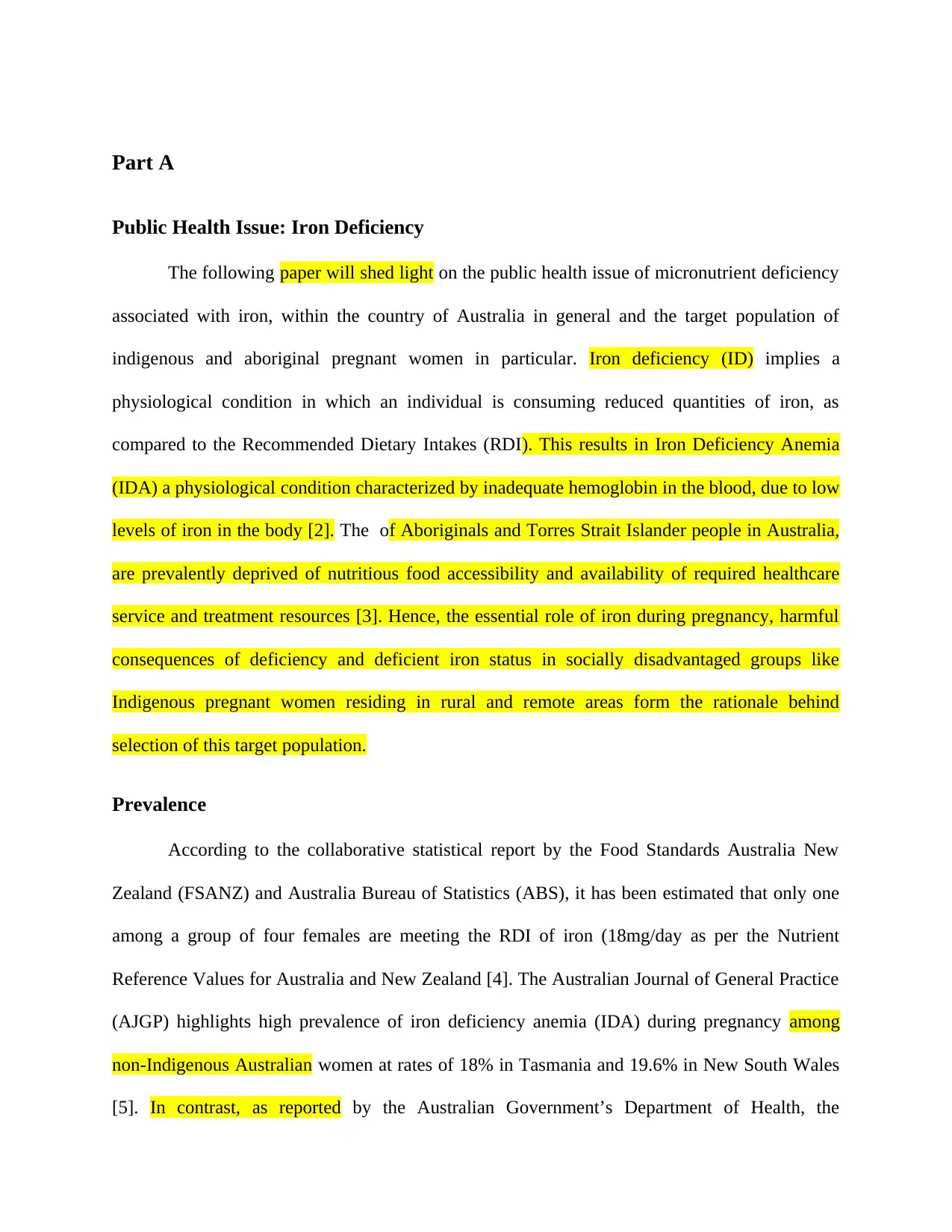
Part A
Public Health Issue: Iron Deficiency
The following paper will shed light on the public health issue of micronutrient deficiency
associated with iron, within the country of Australia in general and the target population of
indigenous and aboriginal pregnant women in particular. Iron deficiency (ID) implies a
physiological condition in which an individual is consuming reduced quantities of iron, as
compared to the Recommended Dietary Intakes (RDI). This results in Iron Deficiency Anemia
(IDA) a physiological condition characterized by inadequate hemoglobin in the blood, due to low
levels of iron in the body [2]. The of Aboriginals and Torres Strait Islander people in Australia,
are prevalently deprived of nutritious food accessibility and availability of required healthcare
service and treatment resources [3]. Hence, the essential role of iron during pregnancy, harmful
consequences of deficiency and deficient iron status in socially disadvantaged groups like
Indigenous pregnant women residing in rural and remote areas form the rationale behind
selection of this target population.
Prevalence
According to the collaborative statistical report by the Food Standards Australia New
Zealand (FSANZ) and Australia Bureau of Statistics (ABS), it has been estimated that only one
among a group of four females are meeting the RDI of iron (18mg/day as per the Nutrient
Reference Values for Australia and New Zealand [4]. The Australian Journal of General Practice
(AJGP) highlights high prevalence of iron deficiency anemia (IDA) during pregnancy among
non-Indigenous Australian women at rates of 18% in Tasmania and 19.6% in New South Wales
[5]. In contrast, as reported by the Australian Government’s Department of Health, the
Public Health Issue: Iron Deficiency
The following paper will shed light on the public health issue of micronutrient deficiency
associated with iron, within the country of Australia in general and the target population of
indigenous and aboriginal pregnant women in particular. Iron deficiency (ID) implies a
physiological condition in which an individual is consuming reduced quantities of iron, as
compared to the Recommended Dietary Intakes (RDI). This results in Iron Deficiency Anemia
(IDA) a physiological condition characterized by inadequate hemoglobin in the blood, due to low
levels of iron in the body [2]. The of Aboriginals and Torres Strait Islander people in Australia,
are prevalently deprived of nutritious food accessibility and availability of required healthcare
service and treatment resources [3]. Hence, the essential role of iron during pregnancy, harmful
consequences of deficiency and deficient iron status in socially disadvantaged groups like
Indigenous pregnant women residing in rural and remote areas form the rationale behind
selection of this target population.
Prevalence
According to the collaborative statistical report by the Food Standards Australia New
Zealand (FSANZ) and Australia Bureau of Statistics (ABS), it has been estimated that only one
among a group of four females are meeting the RDI of iron (18mg/day as per the Nutrient
Reference Values for Australia and New Zealand [4]. The Australian Journal of General Practice
(AJGP) highlights high prevalence of iron deficiency anemia (IDA) during pregnancy among
non-Indigenous Australian women at rates of 18% in Tasmania and 19.6% in New South Wales
[5]. In contrast, as reported by the Australian Government’s Department of Health, the
⊘ This is a preview!⊘
Do you want full access?
Subscribe today to unlock all pages.

Trusted by 1+ million students worldwide
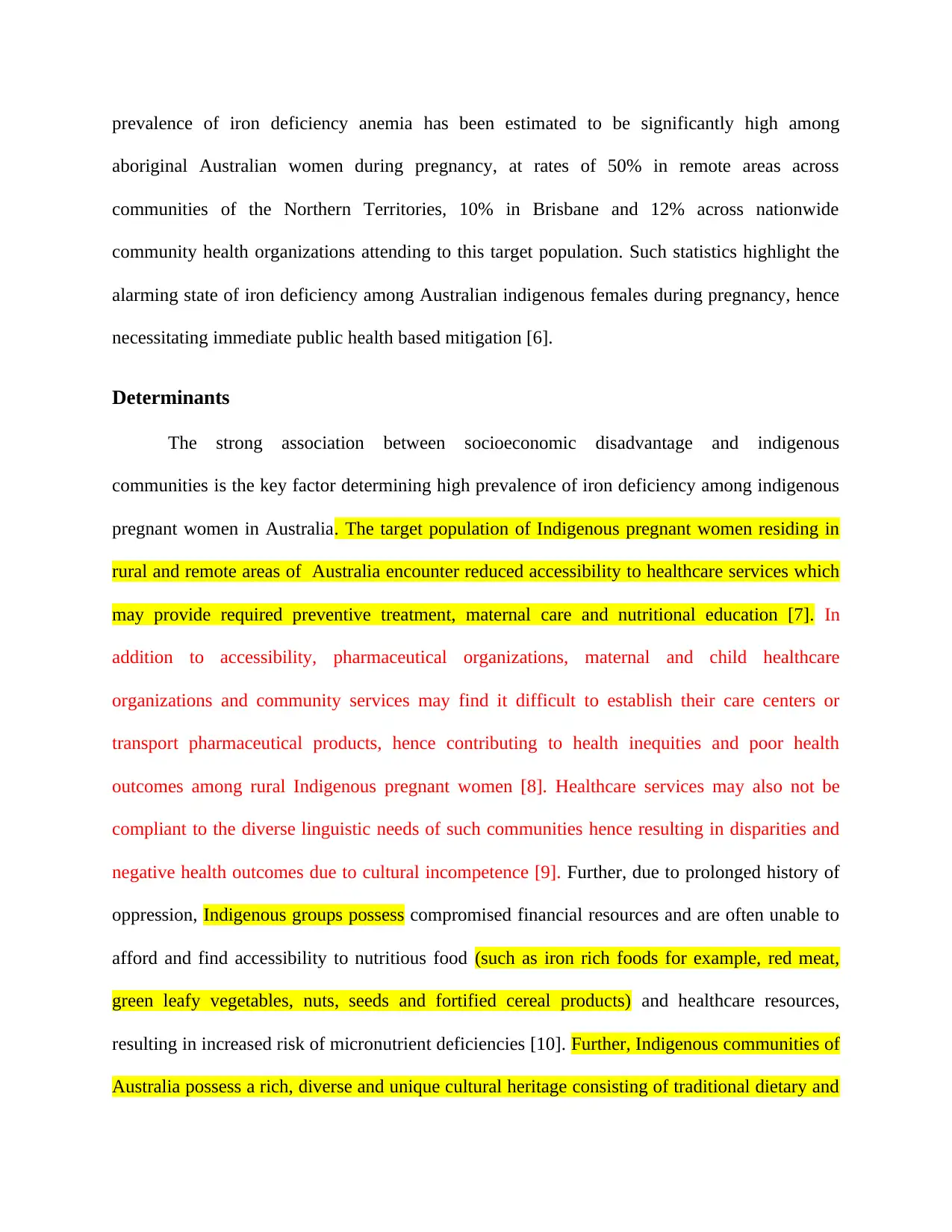
prevalence of iron deficiency anemia has been estimated to be significantly high among
aboriginal Australian women during pregnancy, at rates of 50% in remote areas across
communities of the Northern Territories, 10% in Brisbane and 12% across nationwide
community health organizations attending to this target population. Such statistics highlight the
alarming state of iron deficiency among Australian indigenous females during pregnancy, hence
necessitating immediate public health based mitigation [6].
Determinants
The strong association between socioeconomic disadvantage and indigenous
communities is the key factor determining high prevalence of iron deficiency among indigenous
pregnant women in Australia. The target population of Indigenous pregnant women residing in
rural and remote areas of Australia encounter reduced accessibility to healthcare services which
may provide required preventive treatment, maternal care and nutritional education [7]. In
addition to accessibility, pharmaceutical organizations, maternal and child healthcare
organizations and community services may find it difficult to establish their care centers or
transport pharmaceutical products, hence contributing to health inequities and poor health
outcomes among rural Indigenous pregnant women [8]. Healthcare services may also not be
compliant to the diverse linguistic needs of such communities hence resulting in disparities and
negative health outcomes due to cultural incompetence [9]. Further, due to prolonged history of
oppression, Indigenous groups possess compromised financial resources and are often unable to
afford and find accessibility to nutritious food (such as iron rich foods for example, red meat,
green leafy vegetables, nuts, seeds and fortified cereal products) and healthcare resources,
resulting in increased risk of micronutrient deficiencies [10]. Further, Indigenous communities of
Australia possess a rich, diverse and unique cultural heritage consisting of traditional dietary and
aboriginal Australian women during pregnancy, at rates of 50% in remote areas across
communities of the Northern Territories, 10% in Brisbane and 12% across nationwide
community health organizations attending to this target population. Such statistics highlight the
alarming state of iron deficiency among Australian indigenous females during pregnancy, hence
necessitating immediate public health based mitigation [6].
Determinants
The strong association between socioeconomic disadvantage and indigenous
communities is the key factor determining high prevalence of iron deficiency among indigenous
pregnant women in Australia. The target population of Indigenous pregnant women residing in
rural and remote areas of Australia encounter reduced accessibility to healthcare services which
may provide required preventive treatment, maternal care and nutritional education [7]. In
addition to accessibility, pharmaceutical organizations, maternal and child healthcare
organizations and community services may find it difficult to establish their care centers or
transport pharmaceutical products, hence contributing to health inequities and poor health
outcomes among rural Indigenous pregnant women [8]. Healthcare services may also not be
compliant to the diverse linguistic needs of such communities hence resulting in disparities and
negative health outcomes due to cultural incompetence [9]. Further, due to prolonged history of
oppression, Indigenous groups possess compromised financial resources and are often unable to
afford and find accessibility to nutritious food (such as iron rich foods for example, red meat,
green leafy vegetables, nuts, seeds and fortified cereal products) and healthcare resources,
resulting in increased risk of micronutrient deficiencies [10]. Further, Indigenous communities of
Australia possess a rich, diverse and unique cultural heritage consisting of traditional dietary and
Paraphrase This Document
Need a fresh take? Get an instant paraphrase of this document with our AI Paraphraser
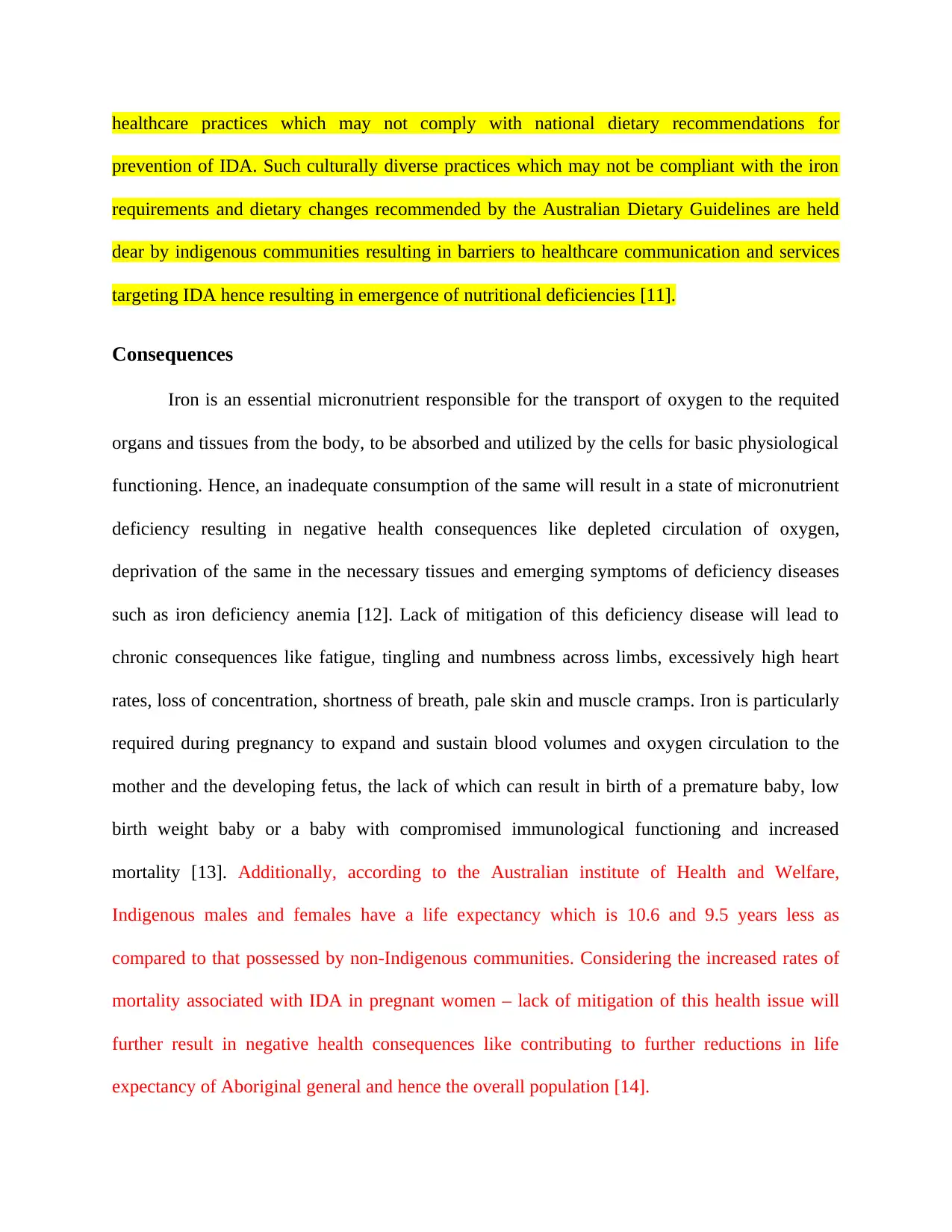
healthcare practices which may not comply with national dietary recommendations for
prevention of IDA. Such culturally diverse practices which may not be compliant with the iron
requirements and dietary changes recommended by the Australian Dietary Guidelines are held
dear by indigenous communities resulting in barriers to healthcare communication and services
targeting IDA hence resulting in emergence of nutritional deficiencies [11].
Consequences
Iron is an essential micronutrient responsible for the transport of oxygen to the requited
organs and tissues from the body, to be absorbed and utilized by the cells for basic physiological
functioning. Hence, an inadequate consumption of the same will result in a state of micronutrient
deficiency resulting in negative health consequences like depleted circulation of oxygen,
deprivation of the same in the necessary tissues and emerging symptoms of deficiency diseases
such as iron deficiency anemia [12]. Lack of mitigation of this deficiency disease will lead to
chronic consequences like fatigue, tingling and numbness across limbs, excessively high heart
rates, loss of concentration, shortness of breath, pale skin and muscle cramps. Iron is particularly
required during pregnancy to expand and sustain blood volumes and oxygen circulation to the
mother and the developing fetus, the lack of which can result in birth of a premature baby, low
birth weight baby or a baby with compromised immunological functioning and increased
mortality [13]. Additionally, according to the Australian institute of Health and Welfare,
Indigenous males and females have a life expectancy which is 10.6 and 9.5 years less as
compared to that possessed by non-Indigenous communities. Considering the increased rates of
mortality associated with IDA in pregnant women – lack of mitigation of this health issue will
further result in negative health consequences like contributing to further reductions in life
expectancy of Aboriginal general and hence the overall population [14].
prevention of IDA. Such culturally diverse practices which may not be compliant with the iron
requirements and dietary changes recommended by the Australian Dietary Guidelines are held
dear by indigenous communities resulting in barriers to healthcare communication and services
targeting IDA hence resulting in emergence of nutritional deficiencies [11].
Consequences
Iron is an essential micronutrient responsible for the transport of oxygen to the requited
organs and tissues from the body, to be absorbed and utilized by the cells for basic physiological
functioning. Hence, an inadequate consumption of the same will result in a state of micronutrient
deficiency resulting in negative health consequences like depleted circulation of oxygen,
deprivation of the same in the necessary tissues and emerging symptoms of deficiency diseases
such as iron deficiency anemia [12]. Lack of mitigation of this deficiency disease will lead to
chronic consequences like fatigue, tingling and numbness across limbs, excessively high heart
rates, loss of concentration, shortness of breath, pale skin and muscle cramps. Iron is particularly
required during pregnancy to expand and sustain blood volumes and oxygen circulation to the
mother and the developing fetus, the lack of which can result in birth of a premature baby, low
birth weight baby or a baby with compromised immunological functioning and increased
mortality [13]. Additionally, according to the Australian institute of Health and Welfare,
Indigenous males and females have a life expectancy which is 10.6 and 9.5 years less as
compared to that possessed by non-Indigenous communities. Considering the increased rates of
mortality associated with IDA in pregnant women – lack of mitigation of this health issue will
further result in negative health consequences like contributing to further reductions in life
expectancy of Aboriginal general and hence the overall population [14].
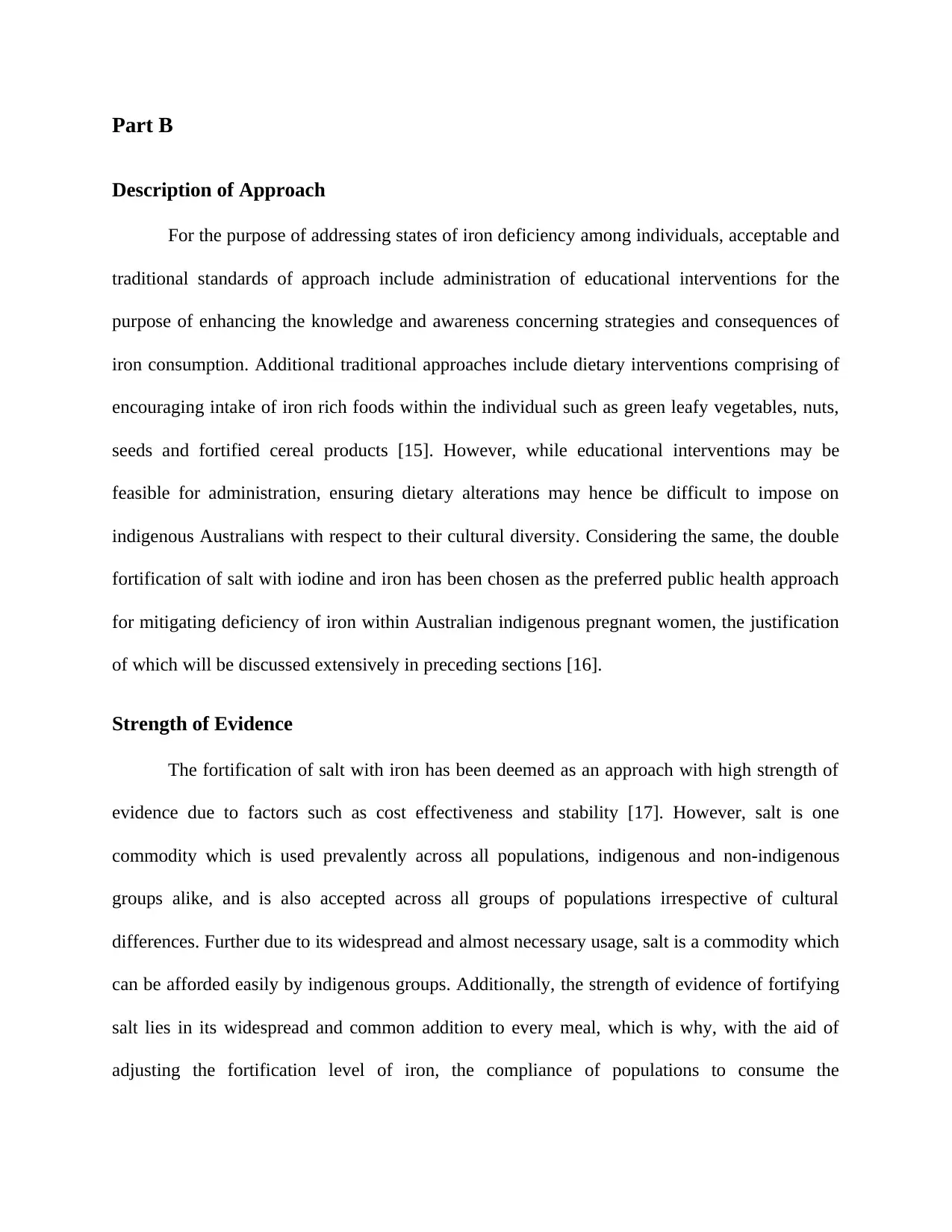
Part B
Description of Approach
For the purpose of addressing states of iron deficiency among individuals, acceptable and
traditional standards of approach include administration of educational interventions for the
purpose of enhancing the knowledge and awareness concerning strategies and consequences of
iron consumption. Additional traditional approaches include dietary interventions comprising of
encouraging intake of iron rich foods within the individual such as green leafy vegetables, nuts,
seeds and fortified cereal products [15]. However, while educational interventions may be
feasible for administration, ensuring dietary alterations may hence be difficult to impose on
indigenous Australians with respect to their cultural diversity. Considering the same, the double
fortification of salt with iodine and iron has been chosen as the preferred public health approach
for mitigating deficiency of iron within Australian indigenous pregnant women, the justification
of which will be discussed extensively in preceding sections [16].
Strength of Evidence
The fortification of salt with iron has been deemed as an approach with high strength of
evidence due to factors such as cost effectiveness and stability [17]. However, salt is one
commodity which is used prevalently across all populations, indigenous and non-indigenous
groups alike, and is also accepted across all groups of populations irrespective of cultural
differences. Further due to its widespread and almost necessary usage, salt is a commodity which
can be afforded easily by indigenous groups. Additionally, the strength of evidence of fortifying
salt lies in its widespread and common addition to every meal, which is why, with the aid of
adjusting the fortification level of iron, the compliance of populations to consume the
Description of Approach
For the purpose of addressing states of iron deficiency among individuals, acceptable and
traditional standards of approach include administration of educational interventions for the
purpose of enhancing the knowledge and awareness concerning strategies and consequences of
iron consumption. Additional traditional approaches include dietary interventions comprising of
encouraging intake of iron rich foods within the individual such as green leafy vegetables, nuts,
seeds and fortified cereal products [15]. However, while educational interventions may be
feasible for administration, ensuring dietary alterations may hence be difficult to impose on
indigenous Australians with respect to their cultural diversity. Considering the same, the double
fortification of salt with iodine and iron has been chosen as the preferred public health approach
for mitigating deficiency of iron within Australian indigenous pregnant women, the justification
of which will be discussed extensively in preceding sections [16].
Strength of Evidence
The fortification of salt with iron has been deemed as an approach with high strength of
evidence due to factors such as cost effectiveness and stability [17]. However, salt is one
commodity which is used prevalently across all populations, indigenous and non-indigenous
groups alike, and is also accepted across all groups of populations irrespective of cultural
differences. Further due to its widespread and almost necessary usage, salt is a commodity which
can be afforded easily by indigenous groups. Additionally, the strength of evidence of fortifying
salt lies in its widespread and common addition to every meal, which is why, with the aid of
adjusting the fortification level of iron, the compliance of populations to consume the
⊘ This is a preview!⊘
Do you want full access?
Subscribe today to unlock all pages.

Trusted by 1+ million students worldwide
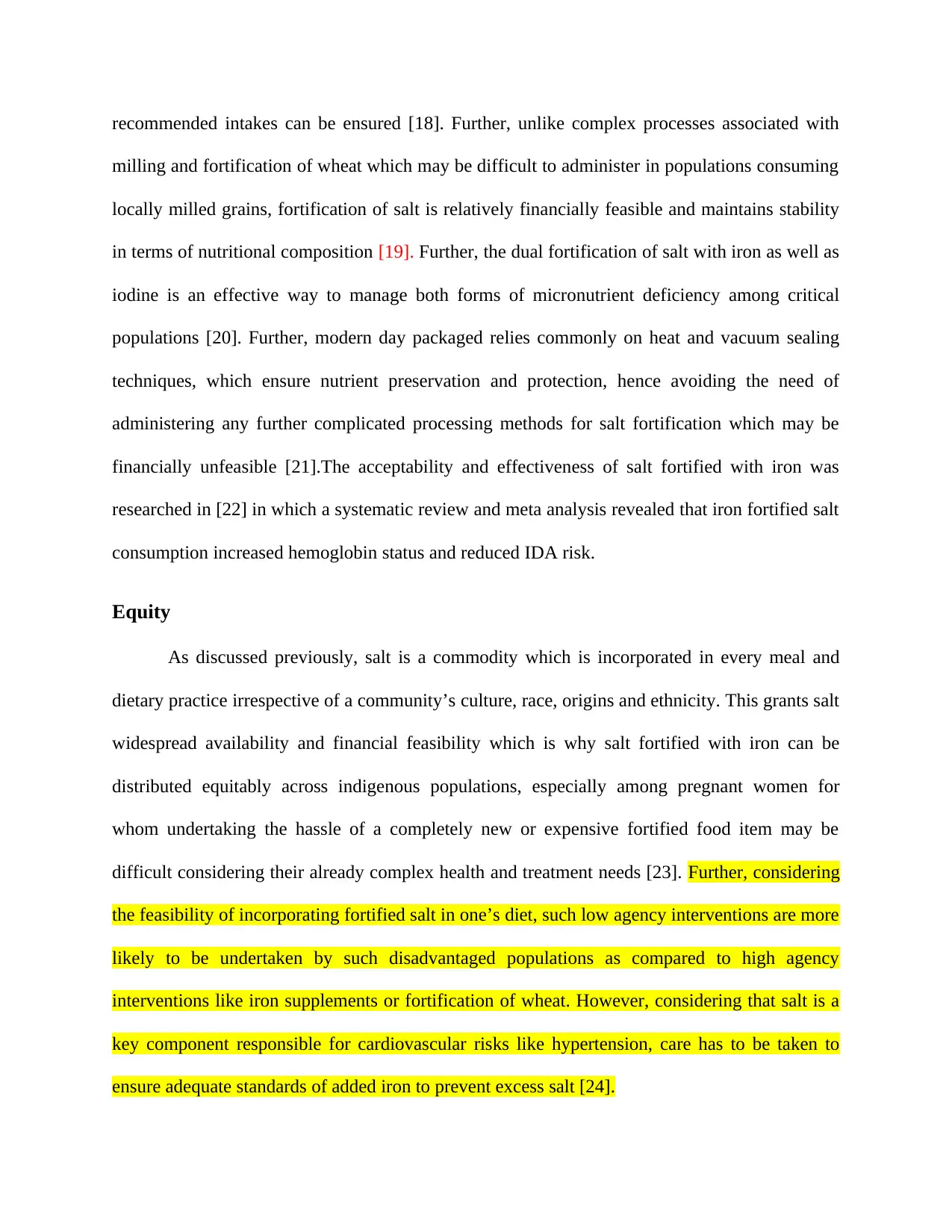
recommended intakes can be ensured [18]. Further, unlike complex processes associated with
milling and fortification of wheat which may be difficult to administer in populations consuming
locally milled grains, fortification of salt is relatively financially feasible and maintains stability
in terms of nutritional composition [19]. Further, the dual fortification of salt with iron as well as
iodine is an effective way to manage both forms of micronutrient deficiency among critical
populations [20]. Further, modern day packaged relies commonly on heat and vacuum sealing
techniques, which ensure nutrient preservation and protection, hence avoiding the need of
administering any further complicated processing methods for salt fortification which may be
financially unfeasible [21].The acceptability and effectiveness of salt fortified with iron was
researched in [22] in which a systematic review and meta analysis revealed that iron fortified salt
consumption increased hemoglobin status and reduced IDA risk.
Equity
As discussed previously, salt is a commodity which is incorporated in every meal and
dietary practice irrespective of a community’s culture, race, origins and ethnicity. This grants salt
widespread availability and financial feasibility which is why salt fortified with iron can be
distributed equitably across indigenous populations, especially among pregnant women for
whom undertaking the hassle of a completely new or expensive fortified food item may be
difficult considering their already complex health and treatment needs [23]. Further, considering
the feasibility of incorporating fortified salt in one’s diet, such low agency interventions are more
likely to be undertaken by such disadvantaged populations as compared to high agency
interventions like iron supplements or fortification of wheat. However, considering that salt is a
key component responsible for cardiovascular risks like hypertension, care has to be taken to
ensure adequate standards of added iron to prevent excess salt [24].
milling and fortification of wheat which may be difficult to administer in populations consuming
locally milled grains, fortification of salt is relatively financially feasible and maintains stability
in terms of nutritional composition [19]. Further, the dual fortification of salt with iron as well as
iodine is an effective way to manage both forms of micronutrient deficiency among critical
populations [20]. Further, modern day packaged relies commonly on heat and vacuum sealing
techniques, which ensure nutrient preservation and protection, hence avoiding the need of
administering any further complicated processing methods for salt fortification which may be
financially unfeasible [21].The acceptability and effectiveness of salt fortified with iron was
researched in [22] in which a systematic review and meta analysis revealed that iron fortified salt
consumption increased hemoglobin status and reduced IDA risk.
Equity
As discussed previously, salt is a commodity which is incorporated in every meal and
dietary practice irrespective of a community’s culture, race, origins and ethnicity. This grants salt
widespread availability and financial feasibility which is why salt fortified with iron can be
distributed equitably across indigenous populations, especially among pregnant women for
whom undertaking the hassle of a completely new or expensive fortified food item may be
difficult considering their already complex health and treatment needs [23]. Further, considering
the feasibility of incorporating fortified salt in one’s diet, such low agency interventions are more
likely to be undertaken by such disadvantaged populations as compared to high agency
interventions like iron supplements or fortification of wheat. However, considering that salt is a
key component responsible for cardiovascular risks like hypertension, care has to be taken to
ensure adequate standards of added iron to prevent excess salt [24].
Paraphrase This Document
Need a fresh take? Get an instant paraphrase of this document with our AI Paraphraser
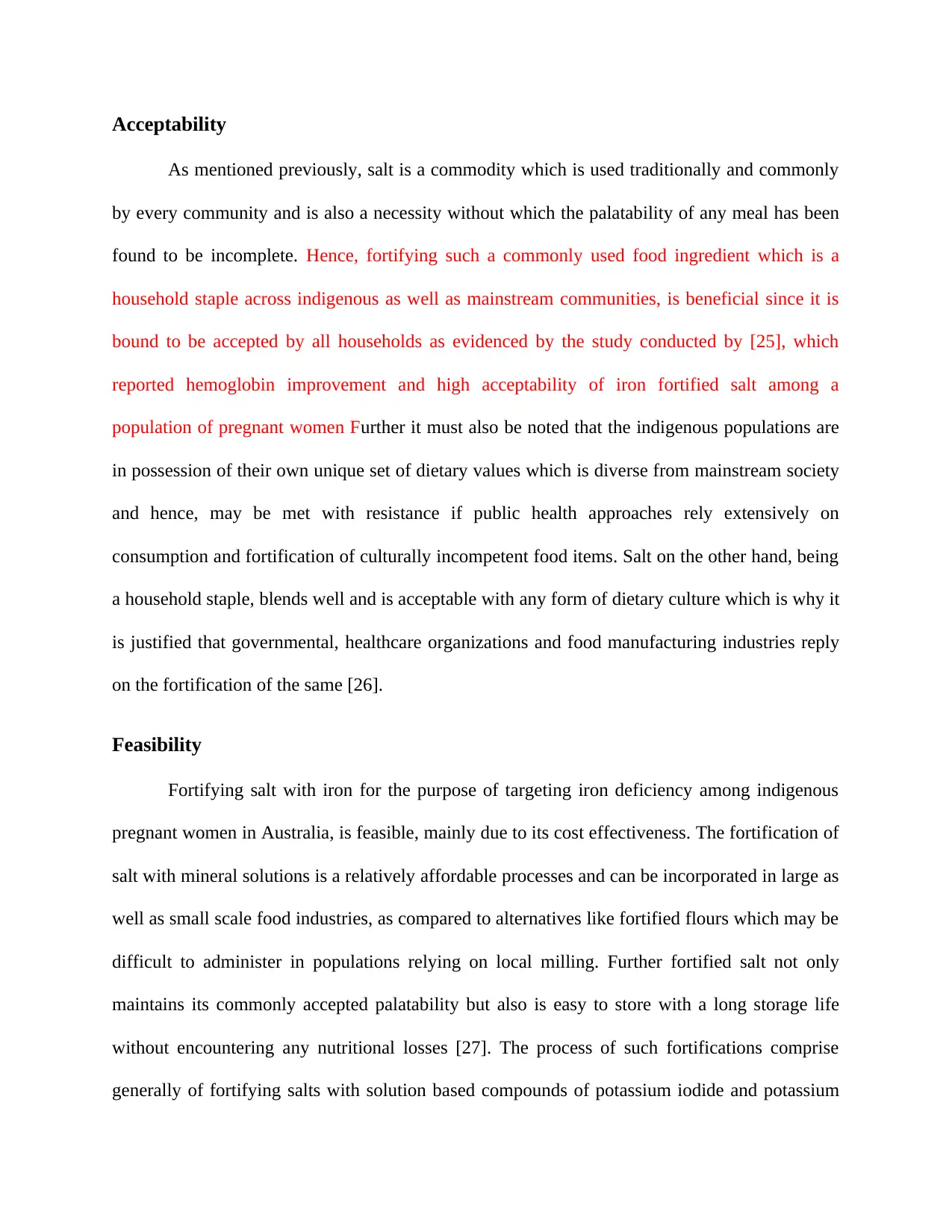
Acceptability
As mentioned previously, salt is a commodity which is used traditionally and commonly
by every community and is also a necessity without which the palatability of any meal has been
found to be incomplete. Hence, fortifying such a commonly used food ingredient which is a
household staple across indigenous as well as mainstream communities, is beneficial since it is
bound to be accepted by all households as evidenced by the study conducted by [25], which
reported hemoglobin improvement and high acceptability of iron fortified salt among a
population of pregnant women Further it must also be noted that the indigenous populations are
in possession of their own unique set of dietary values which is diverse from mainstream society
and hence, may be met with resistance if public health approaches rely extensively on
consumption and fortification of culturally incompetent food items. Salt on the other hand, being
a household staple, blends well and is acceptable with any form of dietary culture which is why it
is justified that governmental, healthcare organizations and food manufacturing industries reply
on the fortification of the same [26].
Feasibility
Fortifying salt with iron for the purpose of targeting iron deficiency among indigenous
pregnant women in Australia, is feasible, mainly due to its cost effectiveness. The fortification of
salt with mineral solutions is a relatively affordable processes and can be incorporated in large as
well as small scale food industries, as compared to alternatives like fortified flours which may be
difficult to administer in populations relying on local milling. Further fortified salt not only
maintains its commonly accepted palatability but also is easy to store with a long storage life
without encountering any nutritional losses [27]. The process of such fortifications comprise
generally of fortifying salts with solution based compounds of potassium iodide and potassium
As mentioned previously, salt is a commodity which is used traditionally and commonly
by every community and is also a necessity without which the palatability of any meal has been
found to be incomplete. Hence, fortifying such a commonly used food ingredient which is a
household staple across indigenous as well as mainstream communities, is beneficial since it is
bound to be accepted by all households as evidenced by the study conducted by [25], which
reported hemoglobin improvement and high acceptability of iron fortified salt among a
population of pregnant women Further it must also be noted that the indigenous populations are
in possession of their own unique set of dietary values which is diverse from mainstream society
and hence, may be met with resistance if public health approaches rely extensively on
consumption and fortification of culturally incompetent food items. Salt on the other hand, being
a household staple, blends well and is acceptable with any form of dietary culture which is why it
is justified that governmental, healthcare organizations and food manufacturing industries reply
on the fortification of the same [26].
Feasibility
Fortifying salt with iron for the purpose of targeting iron deficiency among indigenous
pregnant women in Australia, is feasible, mainly due to its cost effectiveness. The fortification of
salt with mineral solutions is a relatively affordable processes and can be incorporated in large as
well as small scale food industries, as compared to alternatives like fortified flours which may be
difficult to administer in populations relying on local milling. Further fortified salt not only
maintains its commonly accepted palatability but also is easy to store with a long storage life
without encountering any nutritional losses [27]. The process of such fortifications comprise
generally of fortifying salts with solution based compounds of potassium iodide and potassium

fumarate, since such a composition has been found to be stable both in terms of storage and
palatability. However, considering that salt is sensitive to moisture, care has to be taken to
package the same using heat sealing techniques for prevention of humidity infiltration coupled
with storage under dry conditions by consumers [28].
Part C
Evidence 1
The aim of the study is to evaluate the efficacy of iron and iodine fortified salt in enhancing iron
status, and hence is of relevance to the chosen topic of encouraging iron fortification of salt as a
proposed public health approach. This study will provide evidence on the effectiveness of salt
fortification with iron in mitigation of iron deficiency [22]. The chosen research design was a
meta analysis of randomized controlled trials of studies evaluating salt fortification efficacy. The
study settings and population consisted of women residing in developing countries which is of
relevance considering the prevalent social disadvantages identified in the topic. Meta analysis
was used for evaluation which is relevant in the categorization of statistical data [22]. The results
indicate an increase in the level of hemoglobin 0.44 g/dl and decrease in the risk of anemia and
iron deficiency upon intake of iron fortified salt as compared to iron supplementation, which
confirms previous researches on effectiveness by a risk difference of 0.20 [22].
The strength of this study lies in its provision of a large range of pooled data with large
sample sizes without any form of publication bias, along with contributing a high level of
evidence of 2.a in terms of systematic review and meta analysis of non-consecutive patients. The
high rates of heterogeneity as well as poor reporting of randomized controlled trials chosen were
the limitations [22]. This study is of relevance to the chosen topic since it confirms and validates
palatability. However, considering that salt is sensitive to moisture, care has to be taken to
package the same using heat sealing techniques for prevention of humidity infiltration coupled
with storage under dry conditions by consumers [28].
Part C
Evidence 1
The aim of the study is to evaluate the efficacy of iron and iodine fortified salt in enhancing iron
status, and hence is of relevance to the chosen topic of encouraging iron fortification of salt as a
proposed public health approach. This study will provide evidence on the effectiveness of salt
fortification with iron in mitigation of iron deficiency [22]. The chosen research design was a
meta analysis of randomized controlled trials of studies evaluating salt fortification efficacy. The
study settings and population consisted of women residing in developing countries which is of
relevance considering the prevalent social disadvantages identified in the topic. Meta analysis
was used for evaluation which is relevant in the categorization of statistical data [22]. The results
indicate an increase in the level of hemoglobin 0.44 g/dl and decrease in the risk of anemia and
iron deficiency upon intake of iron fortified salt as compared to iron supplementation, which
confirms previous researches on effectiveness by a risk difference of 0.20 [22].
The strength of this study lies in its provision of a large range of pooled data with large
sample sizes without any form of publication bias, along with contributing a high level of
evidence of 2.a in terms of systematic review and meta analysis of non-consecutive patients. The
high rates of heterogeneity as well as poor reporting of randomized controlled trials chosen were
the limitations [22]. This study is of relevance to the chosen topic since it confirms and validates
⊘ This is a preview!⊘
Do you want full access?
Subscribe today to unlock all pages.

Trusted by 1+ million students worldwide
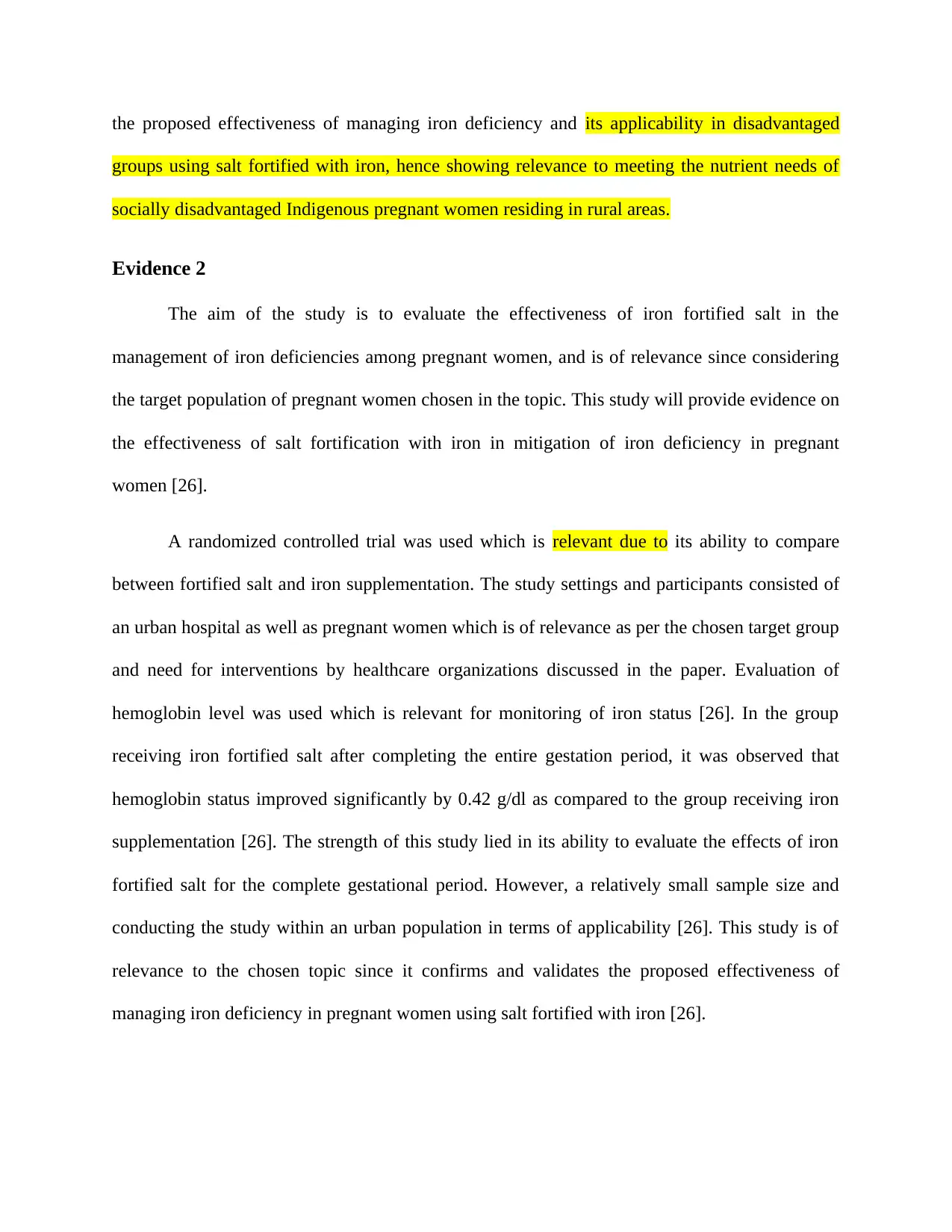
the proposed effectiveness of managing iron deficiency and its applicability in disadvantaged
groups using salt fortified with iron, hence showing relevance to meeting the nutrient needs of
socially disadvantaged Indigenous pregnant women residing in rural areas.
Evidence 2
The aim of the study is to evaluate the effectiveness of iron fortified salt in the
management of iron deficiencies among pregnant women, and is of relevance since considering
the target population of pregnant women chosen in the topic. This study will provide evidence on
the effectiveness of salt fortification with iron in mitigation of iron deficiency in pregnant
women [26].
A randomized controlled trial was used which is relevant due to its ability to compare
between fortified salt and iron supplementation. The study settings and participants consisted of
an urban hospital as well as pregnant women which is of relevance as per the chosen target group
and need for interventions by healthcare organizations discussed in the paper. Evaluation of
hemoglobin level was used which is relevant for monitoring of iron status [26]. In the group
receiving iron fortified salt after completing the entire gestation period, it was observed that
hemoglobin status improved significantly by 0.42 g/dl as compared to the group receiving iron
supplementation [26]. The strength of this study lied in its ability to evaluate the effects of iron
fortified salt for the complete gestational period. However, a relatively small sample size and
conducting the study within an urban population in terms of applicability [26]. This study is of
relevance to the chosen topic since it confirms and validates the proposed effectiveness of
managing iron deficiency in pregnant women using salt fortified with iron [26].
groups using salt fortified with iron, hence showing relevance to meeting the nutrient needs of
socially disadvantaged Indigenous pregnant women residing in rural areas.
Evidence 2
The aim of the study is to evaluate the effectiveness of iron fortified salt in the
management of iron deficiencies among pregnant women, and is of relevance since considering
the target population of pregnant women chosen in the topic. This study will provide evidence on
the effectiveness of salt fortification with iron in mitigation of iron deficiency in pregnant
women [26].
A randomized controlled trial was used which is relevant due to its ability to compare
between fortified salt and iron supplementation. The study settings and participants consisted of
an urban hospital as well as pregnant women which is of relevance as per the chosen target group
and need for interventions by healthcare organizations discussed in the paper. Evaluation of
hemoglobin level was used which is relevant for monitoring of iron status [26]. In the group
receiving iron fortified salt after completing the entire gestation period, it was observed that
hemoglobin status improved significantly by 0.42 g/dl as compared to the group receiving iron
supplementation [26]. The strength of this study lied in its ability to evaluate the effects of iron
fortified salt for the complete gestational period. However, a relatively small sample size and
conducting the study within an urban population in terms of applicability [26]. This study is of
relevance to the chosen topic since it confirms and validates the proposed effectiveness of
managing iron deficiency in pregnant women using salt fortified with iron [26].
Paraphrase This Document
Need a fresh take? Get an instant paraphrase of this document with our AI Paraphraser

Conclusion
Hence, to conclude, it can be observed that the prevalence of iron deficiency across
indigenous pregnant women in Australia is widespread and hence, requires immediate
management by public health organizations such as governmental bodies and community
healthcare centers. Socioeconomic disadvantages coupled with cultural diversity are the primary
causative factors underlying iron deficiency across such groups. A public health approach
consisting of fortification of salt with iron proves to be an advantageous approach as per existing
literature, due to its acceptability and feasibility and cost effectiveness.
Hence, to conclude, it can be observed that the prevalence of iron deficiency across
indigenous pregnant women in Australia is widespread and hence, requires immediate
management by public health organizations such as governmental bodies and community
healthcare centers. Socioeconomic disadvantages coupled with cultural diversity are the primary
causative factors underlying iron deficiency across such groups. A public health approach
consisting of fortification of salt with iron proves to be an advantageous approach as per existing
literature, due to its acceptability and feasibility and cost effectiveness.
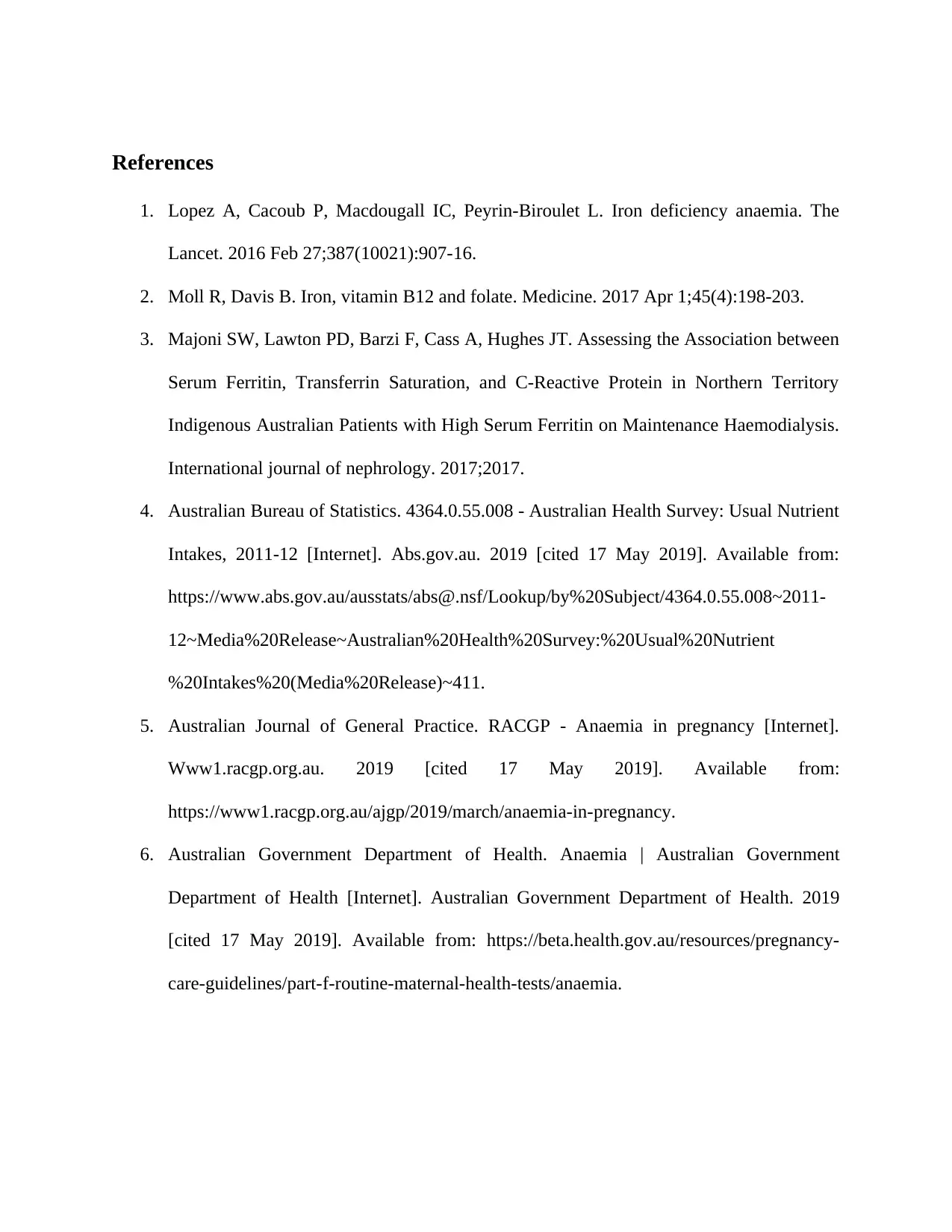
References
1. Lopez A, Cacoub P, Macdougall IC, Peyrin-Biroulet L. Iron deficiency anaemia. The
Lancet. 2016 Feb 27;387(10021):907-16.
2. Moll R, Davis B. Iron, vitamin B12 and folate. Medicine. 2017 Apr 1;45(4):198-203.
3. Majoni SW, Lawton PD, Barzi F, Cass A, Hughes JT. Assessing the Association between
Serum Ferritin, Transferrin Saturation, and C-Reactive Protein in Northern Territory
Indigenous Australian Patients with High Serum Ferritin on Maintenance Haemodialysis.
International journal of nephrology. 2017;2017.
4. Australian Bureau of Statistics. 4364.0.55.008 - Australian Health Survey: Usual Nutrient
Intakes, 2011-12 [Internet]. Abs.gov.au. 2019 [cited 17 May 2019]. Available from:
https://www.abs.gov.au/ausstats/abs@.nsf/Lookup/by%20Subject/4364.0.55.008~2011-
12~Media%20Release~Australian%20Health%20Survey:%20Usual%20Nutrient
%20Intakes%20(Media%20Release)~411.
5. Australian Journal of General Practice. RACGP - Anaemia in pregnancy [Internet].
Www1.racgp.org.au. 2019 [cited 17 May 2019]. Available from:
https://www1.racgp.org.au/ajgp/2019/march/anaemia-in-pregnancy.
6. Australian Government Department of Health. Anaemia | Australian Government
Department of Health [Internet]. Australian Government Department of Health. 2019
[cited 17 May 2019]. Available from: https://beta.health.gov.au/resources/pregnancy-
care-guidelines/part-f-routine-maternal-health-tests/anaemia.
1. Lopez A, Cacoub P, Macdougall IC, Peyrin-Biroulet L. Iron deficiency anaemia. The
Lancet. 2016 Feb 27;387(10021):907-16.
2. Moll R, Davis B. Iron, vitamin B12 and folate. Medicine. 2017 Apr 1;45(4):198-203.
3. Majoni SW, Lawton PD, Barzi F, Cass A, Hughes JT. Assessing the Association between
Serum Ferritin, Transferrin Saturation, and C-Reactive Protein in Northern Territory
Indigenous Australian Patients with High Serum Ferritin on Maintenance Haemodialysis.
International journal of nephrology. 2017;2017.
4. Australian Bureau of Statistics. 4364.0.55.008 - Australian Health Survey: Usual Nutrient
Intakes, 2011-12 [Internet]. Abs.gov.au. 2019 [cited 17 May 2019]. Available from:
https://www.abs.gov.au/ausstats/abs@.nsf/Lookup/by%20Subject/4364.0.55.008~2011-
12~Media%20Release~Australian%20Health%20Survey:%20Usual%20Nutrient
%20Intakes%20(Media%20Release)~411.
5. Australian Journal of General Practice. RACGP - Anaemia in pregnancy [Internet].
Www1.racgp.org.au. 2019 [cited 17 May 2019]. Available from:
https://www1.racgp.org.au/ajgp/2019/march/anaemia-in-pregnancy.
6. Australian Government Department of Health. Anaemia | Australian Government
Department of Health [Internet]. Australian Government Department of Health. 2019
[cited 17 May 2019]. Available from: https://beta.health.gov.au/resources/pregnancy-
care-guidelines/part-f-routine-maternal-health-tests/anaemia.
⊘ This is a preview!⊘
Do you want full access?
Subscribe today to unlock all pages.

Trusted by 1+ million students worldwide
1 out of 16
Related Documents
Your All-in-One AI-Powered Toolkit for Academic Success.
+13062052269
info@desklib.com
Available 24*7 on WhatsApp / Email
![[object Object]](/_next/static/media/star-bottom.7253800d.svg)
Unlock your academic potential
Copyright © 2020–2025 A2Z Services. All Rights Reserved. Developed and managed by ZUCOL.





